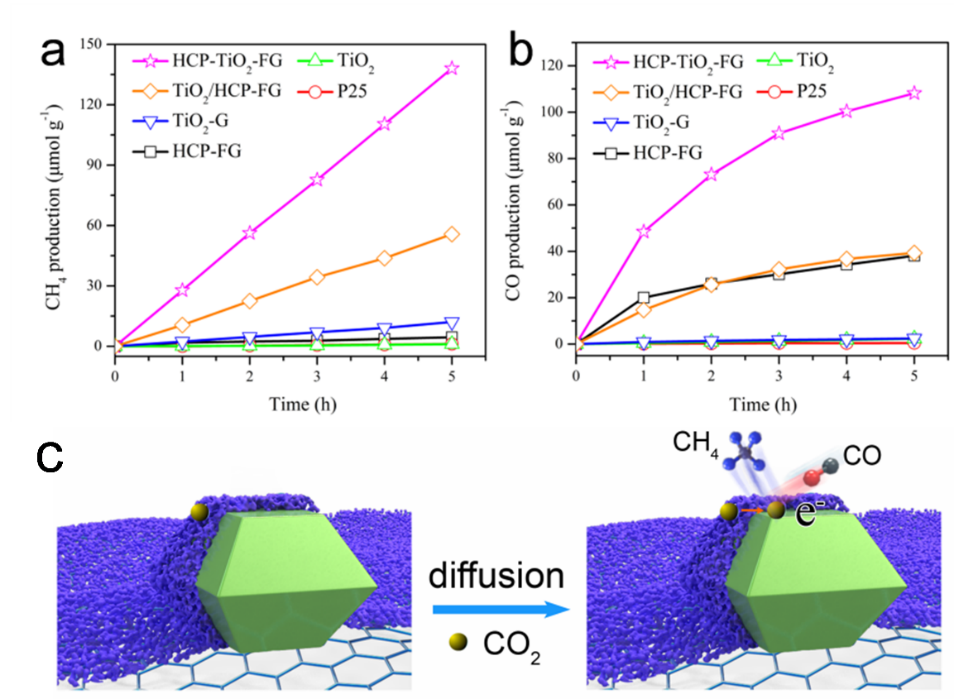News.hust.edu.cn (Correspondent: Wu Jiang’e) The research result titled as Porous Hypercrosslinked Polymer-TiO2-graphene Composite Photocatalysts for Visible-light-driven CO2 Conversion acquired by teams such as Professor Tan Bi’en and the Associate Professor Wang Jingyu in the School of Chemistry and Chemical Engineering was published on Nature Communications on February 8, 2019. The Postdoctor Wang Shaolei of the School of Chemistry and Chemical Engineering and the Postgraduate Xu Min (2015) are the parallel first author of the paper, and Tan Bi’en and Wang Jingyu are the joint corresponding author of the paper. Huazhong University of Science and Technology is the sole corresponding unit. The author of the paper also includes Professor Li Tao of the School of Chemistry and Chemical Engineering, Doctoral student Zhang Chengxin (2014), Professor Peng Tianyou of Wuhan University and Professor Irshad Hussain of Lahore University of Management Sciences.
Consumption of fossil energy and carbon emissions are intensified by rapid development of the society, breaking the balance of carbon cycle of the nature. The “greenhouse gases” in which CO2 plays a predominant role in the atmosphere triggers global warming, leading to energy shortage and series of environmental disasters. How to control the concentration of CO2 in the atmosphere stably has become a research hotspot in the fields of energy and environment in various countries rapidly. Its conversion and utilization can not only mitigate the greenhouse effect, but also can turn itself into available energy in the form of carbon resources. CO2 is a compound with stable thermodynamics, so its activation and conversion require input of the energy of a high electronic form. In other words, numerous conversion technologies of CO2 are featured by potential energy consumption. Solar photocatalysis is an emerging technique for conversion and utilization of CO2. Specifically, the photosynthesis of the nature is simulated to reduce CO2 into chemical fuel by virtue of solar energy, a sustainable clean energy. Such technique wins increasingly wide attention from the public. In practical applications, the adsorptive properties of catalyst for CO2 are weakened since the specific surface area of the semiconductor photocatalyst itself is low and lacking of pores matching with absorption of CO2, which limited improvement of the reduction efficiency of CO2 significantly. Consequently, to realize a higher photo-reduction CO2 activity for photocatalyst, the materials shall be designed with a higher adsorbing capacity for CO2 and a shorter diffusion distance between the adsorption site and the catalytic site.
For the new concept proposed by Tan Bi’en and Wang Jingyu that the porous materials can help visible-light-driven CO2 conversion, the common photocatalytic material TiO2- graphene is taken as the research model. One layer of 3-8nm-thick porous hypercrosslinked polymer (Fig. 1) is subject to in-situ growth on the surface of functionalized graphene. The specific surface area of the porous hypercrosslinked polymer- TiO2- graphene (HCP-TiO2-FG) composite photocatalysts obtained is up to 988 m2g-1, realizing a higher adsorbing capacity for CO2 and a shorter diffusion distance between the adsorption site and the catalytic site, thus making it conductive for CO2 molecules to get adsorbed and enriched on the surface of TiO2 photocatalyst in the polymer network for catalytic conversion. Moreover, the wide scope of light absorption of the porous hypercrosslinked polymer layer can help expand the scope of light absorption of composite materials to the scope of visible light. Effective catalytic reduction of CO2 of the gas - solid-phase system is realized for the HCP-TiO2-FG catalyst under the driving by these factors even without metallic cocatalyst and sacrificial agent. The productive rate of CH4, a reduced product, is 27.62 μmol g-1h-1, while that of CO is 21.63 μmol g-1h-1. The number of electron consumed by the catalyst is 264 μmol g-1h-1, and the electron selectivity of CH4 is up to 83.7% (Fig. 2). The photocatalytic CO2 conversion efficiency in such research is the highest among the test results under similar reaction conditions in recent years.

Fig. 1 Schematic Diagram for Architectural Strategies of Porous Hypercrosslinked Polymer- TiO2-graphene (HCP-TiO2-FG) Composite Photocatalysts; (I) TiO2-G diazonium functionalization; (II) in-situ weaving of porous organic polymer materials on the surface of TiO2-FG; the figure at the top right corner is the enlarged profile of the composite structure.

Fig. 2 Reduction Efficiency of CO2 of Photocatalyst and the Diffusion Conversion Model at the Adsorption Site; Generating Rate of CH4 (a) and CO (b) under Irradiation of Visible Light (λ≥420 nm); (c) Diffusion Conversion Model of CO2 Molecules Captured on the Surface of Photocatalyst.
The work above is subsidized by Natural Science Foundation of China (NSFC), International Scientific and Technological Cooperation Program (ISTCP), Huazhong University of Science and Technology Independent Innovation Funds - Interdiscipline Key Program, Funds for Postdoctor and Operating Expenses for Basic Scientific Research of Colleges and Universities etc.
